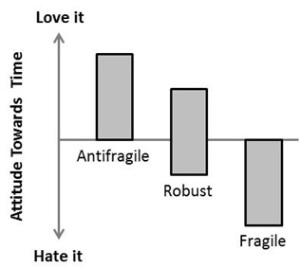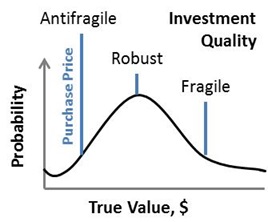Title: Antifragile, Things That Gain From Disorder (Amazon Link)
Author: Nassim Nicholas Taleb
On the surface Antifragile actually deserves a 9/10 rating. The book presents a deceptively simple concept that will be new to many people. However things started to seem repetitive in the latter half of the book and so I took one point off of my rating for every half an hour that I just wanted the book to end. Despite this the core idea deserves your attention.
See below for my explanation of what “Antifragile” means and how this relates to some other concepts that everyone should know about.
The Antifragile Loves Time
A fragile object breaks in the face of sudden or unexpected circumstances. Imagine a vase resting precariously on a windowsill. Your partner arrives home from work and as the front door is opened, a strong gust of wind rushes through the house. Gravity takes over and the vase smashes on the ground.
Clearly fragility brings with it many downsides.
Most people think the opposite of fragile is ‘resilient’, which describes something that can withstand sudden or unexpected changes to the environment. However this is not the true opposite of fragile. Something that is ‘Antifragile’ actually gains strength from sudden or unexpected situations. Indeed, time is the friend of the antifragile and the enemy of the fragile.

Life is Fragile
A large portion of the book is involved with detailing examples of antifragility in action. These are at times surprising and it is clear the author has spent a lot of time thinking about and distilling his thoughts on this concept. Lifting weights induces antifragile behaviour in the body. A stress is applied, leading the body to overcompensate and becomes stronger as a result (provided sufficient nutrition and rest is available). Life is fragile for the individual. A single unfortunate event is enough to kill us. There is a silver lining though. Individual fragility brings antifragility for the species by facilitating the process of evolution. Perspective matters.
A term that is dwelled upon within the book is “iatrogenics”, which basically means a disease or illness caused by a medical practitioner. Let’s say that you are having surgery to remove a relatively minor non-life threatening tumor. However as a result of the surgery you get an infection that kills you. That is an example of iatrogenics and unnecessary exposure to fragility in action.
Antifragility and Investing
Some of you may be familiar with Nassim Taleb’s previous book The Black Swan (Amazon Link). It deals with the fact that we generally have no way to estimate the likelihood of unknown or rare events. However we can usually tell what the magnitude or outcome of such an event happening will be. So when we think about risk we shouldn’t bother focusing too hard on the probabilities that have been conjured up. But rather we should focus on what the maximum outcome might be and mitigate for that. I think this is particularly relevant for investing.

Antifragility manifests itself in the value investing community (and also engineering) through the concept of ‘margin of safety’. Let’s say you value a company and you come up with a fair purchase price that you expect will give decent returns. You then apply a margin of safety of 30% to your estimate and so you only buy the shares when they trade for 70% of what you think they are actually worth. This achieves two things:
- You have reduced your downside exposure to errors in your valuation or future negative unexpected events;
- You have maximised your chance for a better return by buying at a lower price.
You can further engineer an inherent margin of safety into your estimates by deliberately using pessimistic parameters in your valuation (e.g. assuming no or even negative revenue growth, subtracting the value of intangible assets, etc.). Through this process you have simultaneously minimised your risk of losing money and maximised your risk of making money. Lower risk, higher reward.
Final Thoughts
It is refreshing to see original concepts coming to life. My own experience is that it can take months or even years of working around a new concept before you ever have that point of inspiration where it comes to you. While a variety of other authors and disciplines have touched on similar topics, noone else has really articulated the Antifragile concept with such definition before. On that note I definitely recommend reading Antifragile if you are after an education. However if all you want is entertainment and an easy read then look elsewhere.
Thanks for reading. If you have any thoughts on the ‘Antifragile’ concept then leave a comment below.
– Stephen
Click here to find more details and reviews of Antifragile at Amazon.com
– – – – –
Related resources
Interview with Nassim Nicholas Taleb on James Altachur’s podcast.
- This is actually an interesting discussion that goes across a range of topics. However it isn’t for everyone and you will know within several minutes if you will find it useful.
- Banning smoking globally would have an impact larger than the combined impact of the world’s recent health improvements.
- Taleb is a bit of a recluse so it is rare to hear him speak about his more recent work.
- When I listened to this podcast I felt I got a better sense of who Nassim Taleb is as a person. I sensed that Antifragile was written with a certain self-indulgence and I suspect that if I had listened to this podcast first I wouldn’t have felt that.
Also just as a tangent to this post, the most expensive second hand book that I have ever seen is a book released in 1991 by Seth Klarmann entitled Margin of Safety (Amazon Link). I’m a big believer of investing in your financial education, but reading a seminal classic such as The Intelligent Investor (Amazon Link) is probably a more cost effective choice. After all Warren Buffet credits that book with completely changing how he viewed investments.


Simple concept. Nice reminder there is a lot to ponder in the world around us!